White/Caucasian vs Argentinean Community Comparison
COMPARE
White/Caucasian
Argentinean
Social Comparison
Social Comparison
Whites/Caucasians
Argentineans
5,140
SOCIAL INDEX
48.9/ 100
SOCIAL RATING
185th/ 347
SOCIAL RANK
8,055
SOCIAL INDEX
78.0/ 100
SOCIAL RATING
90th/ 347
SOCIAL RANK
Argentinean Integration in White/Caucasian Communities
The statistical analysis conducted on geographies consisting of 297,093,924 people shows a moderate positive correlation between the proportion of Argentineans within White/Caucasian communities in the United States with a correlation coefficient (R) of 0.448. On average, for every 1% (one percent) increase in Whites/Caucasians within a typical geography, there is an increase of 0.001% in Argentineans. To illustrate, in a geography comprising of 100,000 individuals, a rise of 1,000 Whites/Caucasians corresponds to an increase of 1.3 Argentineans.
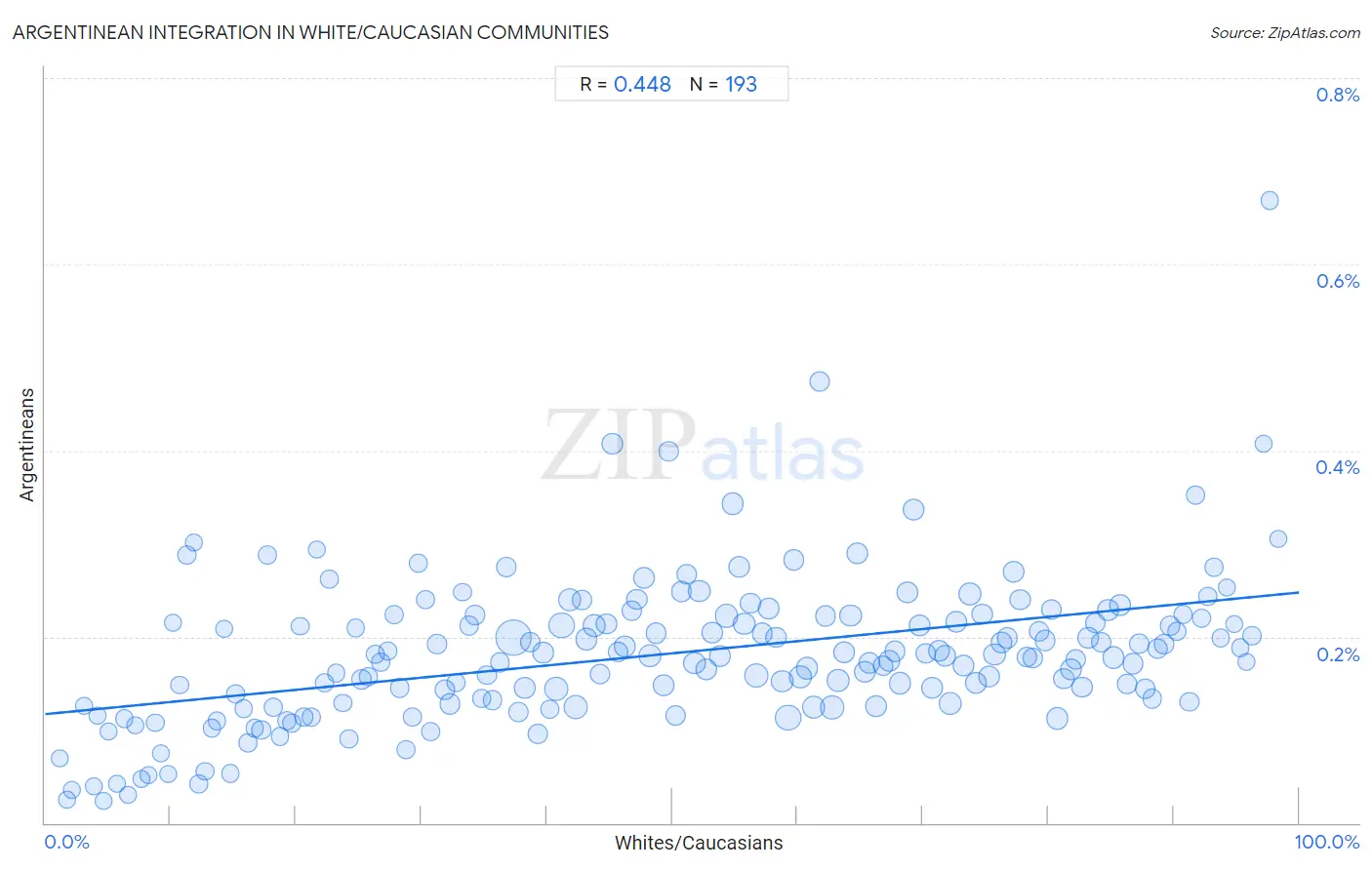
White/Caucasian vs Argentinean Income
When considering income, the most significant differences between White/Caucasian and Argentinean communities in the United States are seen in per capita income ($42,180 compared to $49,862, a difference of 18.2%), median household income ($82,029 compared to $93,960, a difference of 14.5%), and median family income ($99,800 compared to $112,665, a difference of 12.9%). Conversely, both communities are more comparable in terms of wage/income gap (28.5% compared to 27.0%, a difference of 5.7%), householder income under 25 years ($50,336 compared to $54,154, a difference of 7.6%), and householder income over 65 years ($58,847 compared to $65,246, a difference of 10.9%).

| Income Metric | White/Caucasian | Argentinean |
| Per Capita Income | Poor $42,180 | Exceptional $49,862 |
| Median Family Income | Poor $99,800 | Exceptional $112,665 |
| Median Household Income | Poor $82,029 | Exceptional $93,960 |
| Median Earnings | Poor $45,197 | Exceptional $50,399 |
| Median Male Earnings | Fair $53,925 | Exceptional $60,117 |
| Median Female Earnings | Tragic $37,531 | Exceptional $41,952 |
| Householder Age | Under 25 years | Tragic $50,336 | Exceptional $54,154 |
| Householder Age | 25 - 44 years | Poor $91,668 | Exceptional $103,111 |
| Householder Age | 45 - 64 years | Fair $98,091 | Exceptional $110,103 |
| Householder Age | Over 65 years | Tragic $58,847 | Exceptional $65,246 |
| Wage/Income Gap | Tragic 28.5% | Tragic 27.0% |
White/Caucasian vs Argentinean Poverty
When considering poverty, the most significant differences between White/Caucasian and Argentinean communities in the United States are seen in single male poverty (14.5% compared to 11.9%, a difference of 21.6%), single female poverty (22.7% compared to 19.1%, a difference of 18.9%), and child poverty under the age of 5 (18.1% compared to 15.4%, a difference of 17.9%). Conversely, both communities are more comparable in terms of receiving food stamps (11.1% compared to 10.8%, a difference of 2.2%), family poverty (8.8% compared to 8.4%, a difference of 4.7%), and poverty (12.3% compared to 11.7%, a difference of 4.8%).
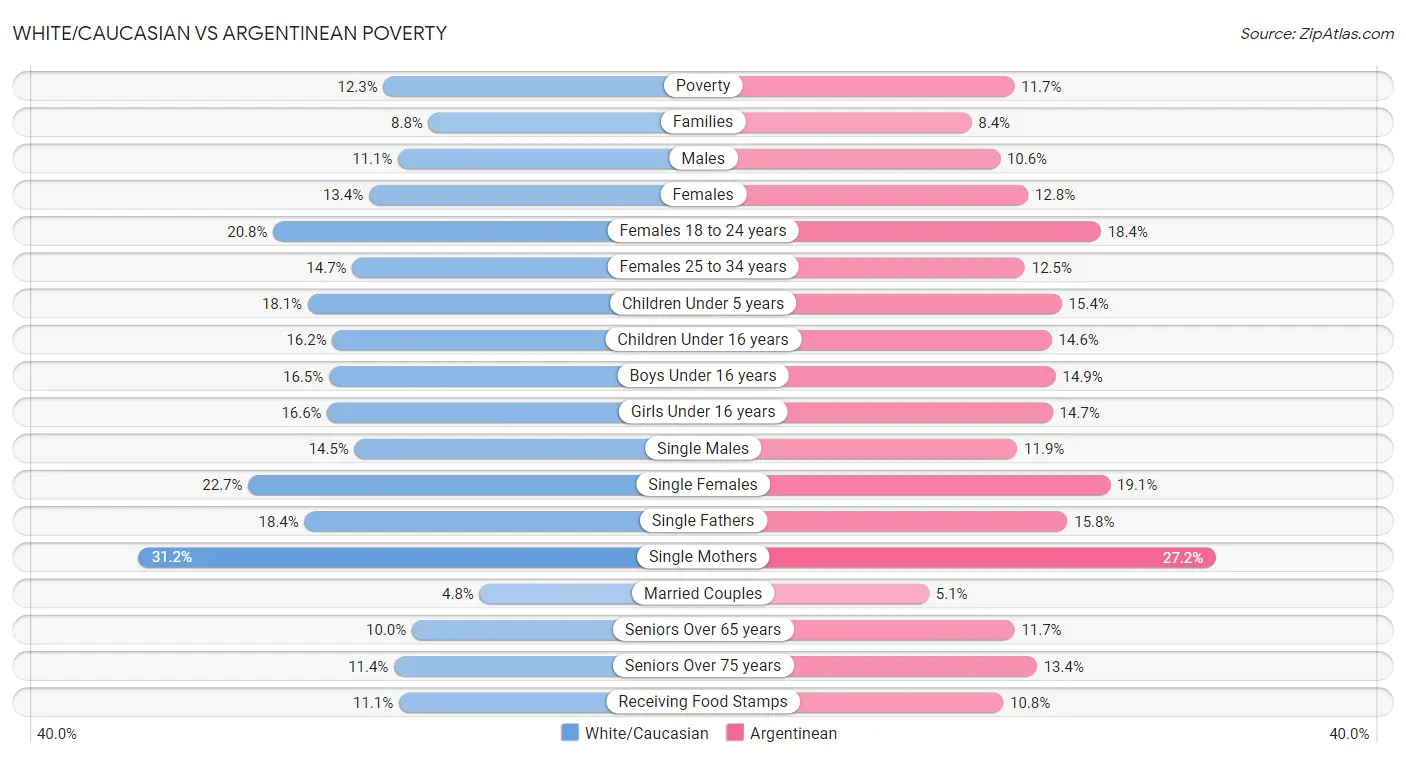
| Poverty Metric | White/Caucasian | Argentinean |
| Poverty | Average 12.3% | Excellent 11.7% |
| Families | Good 8.8% | Excellent 8.4% |
| Males | Average 11.1% | Exceptional 10.6% |
| Females | Average 13.4% | Excellent 12.8% |
| Females 18 to 24 years | Tragic 20.8% | Exceptional 18.4% |
| Females 25 to 34 years | Tragic 14.7% | Exceptional 12.5% |
| Children Under 5 years | Poor 18.1% | Exceptional 15.4% |
| Children Under 16 years | Average 16.2% | Exceptional 14.6% |
| Boys Under 16 years | Average 16.5% | Exceptional 14.9% |
| Girls Under 16 years | Average 16.6% | Exceptional 14.7% |
| Single Males | Tragic 14.5% | Exceptional 11.9% |
| Single Females | Tragic 22.7% | Exceptional 19.1% |
| Single Fathers | Tragic 18.4% | Exceptional 15.8% |
| Single Mothers | Tragic 31.2% | Exceptional 27.2% |
| Married Couples | Exceptional 4.8% | Good 5.1% |
| Seniors Over 65 years | Exceptional 10.0% | Tragic 11.7% |
| Seniors Over 75 years | Exceptional 11.4% | Tragic 13.4% |
| Receiving Food Stamps | Excellent 11.1% | Exceptional 10.8% |
White/Caucasian vs Argentinean Unemployment
When considering unemployment, the most significant differences between White/Caucasian and Argentinean communities in the United States are seen in unemployment among seniors over 75 years (10.1% compared to 7.9%, a difference of 26.8%), unemployment among women with children under 6 years (8.4% compared to 7.2%, a difference of 15.6%), and unemployment among women with children ages 6 to 17 years (9.6% compared to 8.6%, a difference of 11.6%). Conversely, both communities are more comparable in terms of unemployment among women with children under 18 years (5.3% compared to 5.3%, a difference of 0.49%), male unemployment (5.0% compared to 5.0%, a difference of 0.52%), and unemployment among ages 20 to 24 years (10.1% compared to 10.2%, a difference of 0.62%).
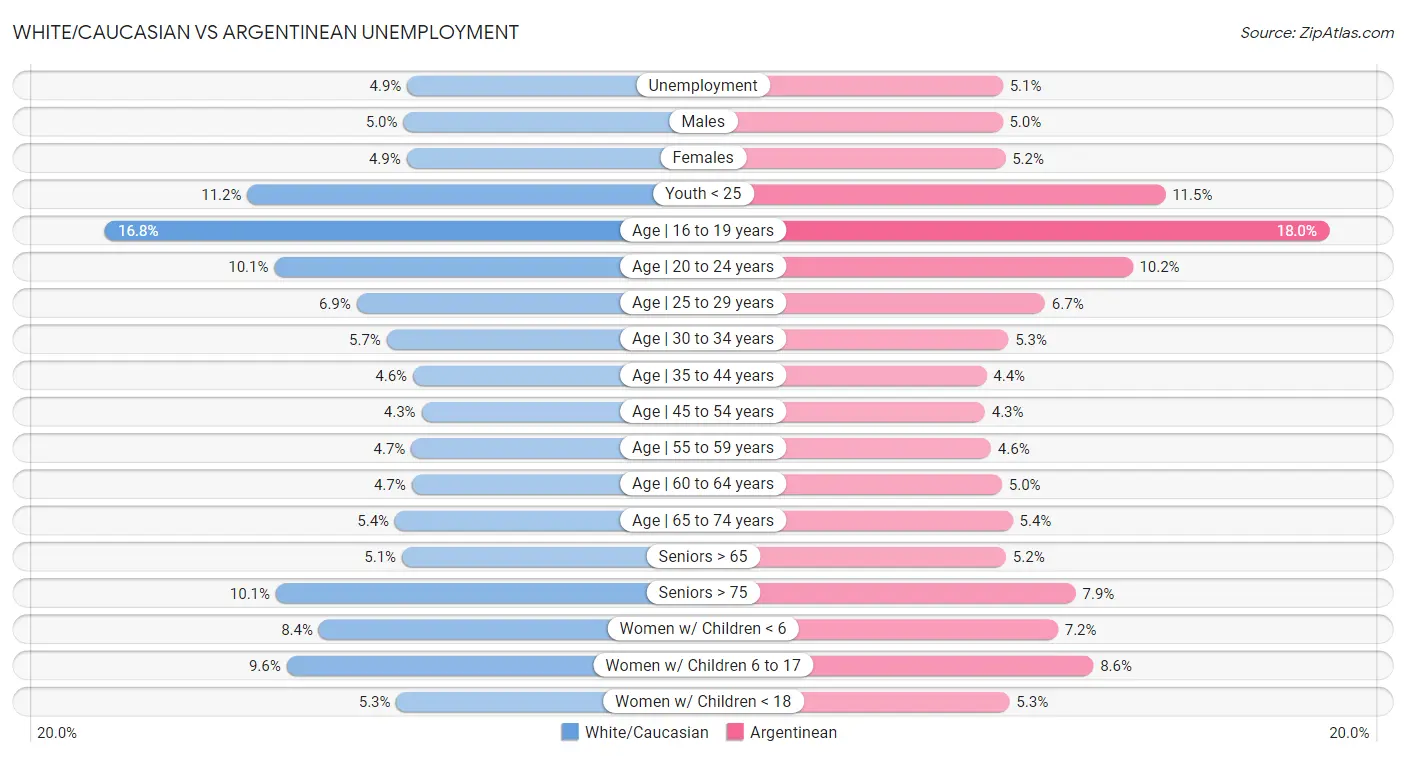
| Unemployment Metric | White/Caucasian | Argentinean |
| Unemployment | Exceptional 4.9% | Exceptional 5.1% |
| Males | Exceptional 5.0% | Exceptional 5.0% |
| Females | Exceptional 4.9% | Good 5.2% |
| Youth < 25 | Exceptional 11.2% | Good 11.5% |
| Age | 16 to 19 years | Exceptional 16.8% | Poor 18.0% |
| Age | 20 to 24 years | Excellent 10.1% | Good 10.2% |
| Age | 25 to 29 years | Poor 6.9% | Fair 6.7% |
| Age | 30 to 34 years | Tragic 5.7% | Excellent 5.3% |
| Age | 35 to 44 years | Good 4.6% | Exceptional 4.4% |
| Age | 45 to 54 years | Exceptional 4.3% | Exceptional 4.3% |
| Age | 55 to 59 years | Exceptional 4.7% | Exceptional 4.6% |
| Age | 60 to 64 years | Exceptional 4.7% | Tragic 5.0% |
| Age | 65 to 74 years | Average 5.4% | Poor 5.4% |
| Seniors > 65 | Excellent 5.1% | Fair 5.2% |
| Seniors > 75 | Tragic 10.1% | Exceptional 7.9% |
| Women w/ Children < 6 | Tragic 8.4% | Exceptional 7.2% |
| Women w/ Children 6 to 17 | Tragic 9.6% | Exceptional 8.6% |
| Women w/ Children < 18 | Excellent 5.3% | Good 5.3% |
White/Caucasian vs Argentinean Labor Participation
When considering labor participation, the most significant differences between White/Caucasian and Argentinean communities in the United States are seen in in labor force | age 16-19 (41.3% compared to 33.3%, a difference of 24.1%), in labor force | age 20-24 (76.9% compared to 73.1%, a difference of 5.3%), and in labor force | age > 16 (63.6% compared to 65.7%, a difference of 3.4%). Conversely, both communities are more comparable in terms of in labor force | age 25-29 (84.2% compared to 84.7%, a difference of 0.61%), in labor force | age 35-44 (83.6% compared to 84.6%, a difference of 1.2%), and in labor force | age 30-34 (83.9% compared to 85.1%, a difference of 1.5%).

| Labor Participation Metric | White/Caucasian | Argentinean |
| In Labor Force | Age > 16 | Tragic 63.6% | Exceptional 65.7% |
| In Labor Force | Age 20-64 | Tragic 78.5% | Exceptional 80.0% |
| In Labor Force | Age 16-19 | Exceptional 41.3% | Tragic 33.3% |
| In Labor Force | Age 20-24 | Exceptional 76.9% | Tragic 73.1% |
| In Labor Force | Age 25-29 | Tragic 84.2% | Average 84.7% |
| In Labor Force | Age 30-34 | Tragic 83.9% | Exceptional 85.1% |
| In Labor Force | Age 35-44 | Tragic 83.6% | Excellent 84.6% |
| In Labor Force | Age 45-54 | Tragic 81.9% | Exceptional 83.3% |
White/Caucasian vs Argentinean Family Structure
When considering family structure, the most significant differences between White/Caucasian and Argentinean communities in the United States are seen in single father households (2.4% compared to 2.1%, a difference of 11.5%), births to unmarried women (33.3% compared to 30.0%, a difference of 10.9%), and divorced or separated (12.6% compared to 11.9%, a difference of 6.3%). Conversely, both communities are more comparable in terms of family households (65.1% compared to 65.0%, a difference of 0.16%), family households with children (27.4% compared to 27.6%, a difference of 0.71%), and married-couple households (48.6% compared to 47.5%, a difference of 2.2%).

| Family Structure Metric | White/Caucasian | Argentinean |
| Family Households | Exceptional 65.1% | Exceptional 65.0% |
| Family Households with Children | Average 27.4% | Good 27.6% |
| Married-couple Households | Exceptional 48.6% | Exceptional 47.5% |
| Average Family Size | Tragic 3.14 | Average 3.23 |
| Single Father Households | Fair 2.4% | Exceptional 2.1% |
| Single Mother Households | Good 6.1% | Exceptional 5.8% |
| Currently Married | Exceptional 48.6% | Good 47.1% |
| Divorced or Separated | Tragic 12.6% | Excellent 11.9% |
| Births to Unmarried Women | Poor 33.3% | Exceptional 30.0% |
White/Caucasian vs Argentinean Vehicle Availability
When considering vehicle availability, the most significant differences between White/Caucasian and Argentinean communities in the United States are seen in no vehicles in household (7.0% compared to 11.2%, a difference of 59.1%), 4 or more vehicles in household (7.4% compared to 6.2%, a difference of 19.4%), and 3 or more vehicles in household (22.6% compared to 18.9%, a difference of 19.2%). Conversely, both communities are more comparable in terms of 1 or more vehicles in household (93.1% compared to 88.9%, a difference of 4.7%), 2 or more vehicles in household (60.8% compared to 54.5%, a difference of 11.6%), and 3 or more vehicles in household (22.6% compared to 18.9%, a difference of 19.2%).

| Vehicle Availability Metric | White/Caucasian | Argentinean |
| No Vehicles Available | Exceptional 7.0% | Tragic 11.2% |
| 1+ Vehicles Available | Exceptional 93.1% | Tragic 88.9% |
| 2+ Vehicles Available | Exceptional 60.8% | Poor 54.5% |
| 3+ Vehicles Available | Exceptional 22.6% | Poor 18.9% |
| 4+ Vehicles Available | Exceptional 7.4% | Fair 6.2% |
White/Caucasian vs Argentinean Education Level
When considering education level, the most significant differences between White/Caucasian and Argentinean communities in the United States are seen in professional degree (4.1% compared to 5.9%, a difference of 45.5%), master's degree (13.8% compared to 18.2%, a difference of 31.6%), and doctorate degree (1.8% compared to 2.3%, a difference of 29.9%). Conversely, both communities are more comparable in terms of 12th grade, no diploma (91.8% compared to 91.6%, a difference of 0.27%), nursery school (98.5% compared to 98.0%, a difference of 0.49%), and kindergarten (98.4% compared to 97.9%, a difference of 0.50%).
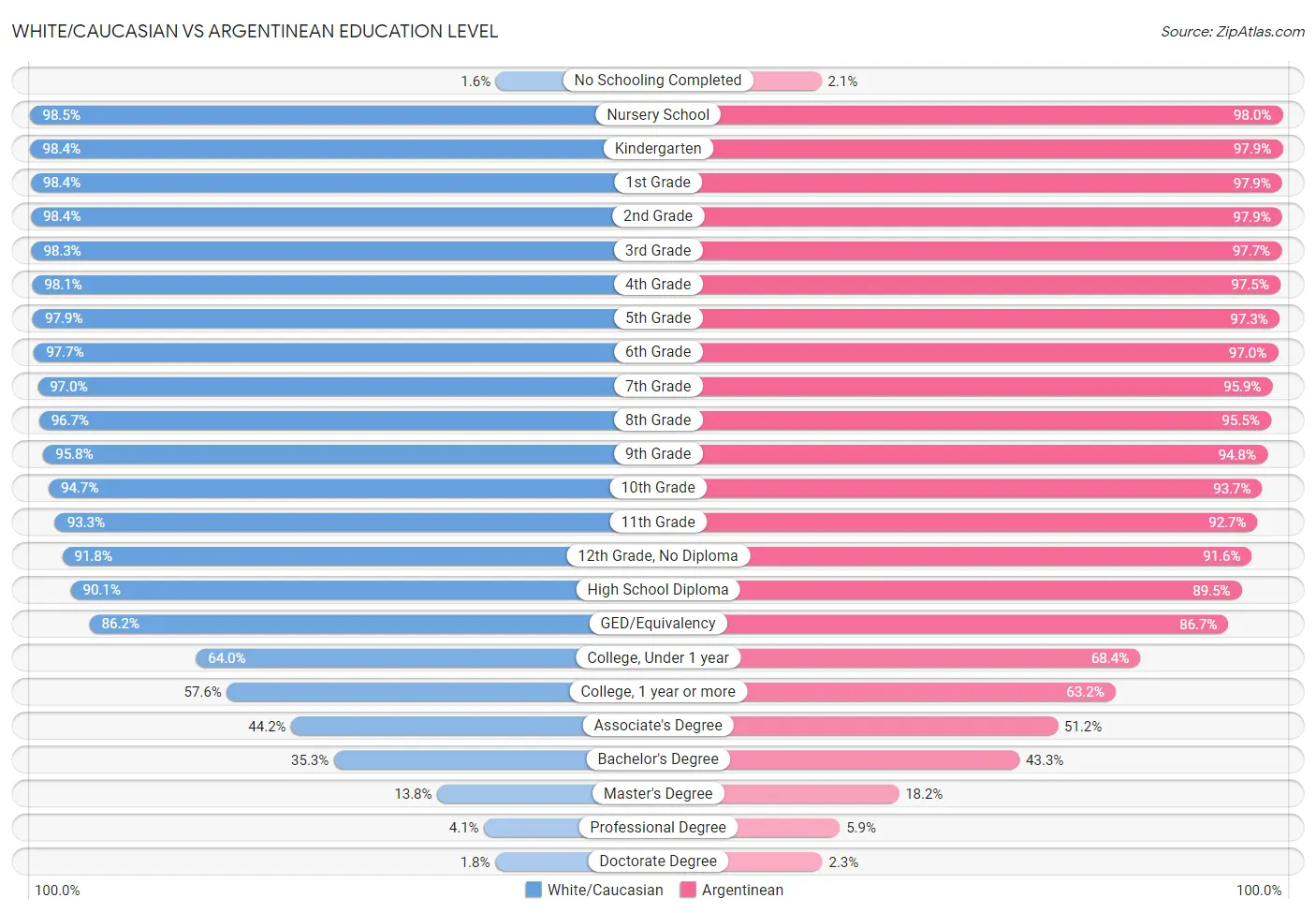
| Education Level Metric | White/Caucasian | Argentinean |
| No Schooling Completed | Exceptional 1.6% | Average 2.1% |
| Nursery School | Exceptional 98.5% | Average 98.0% |
| Kindergarten | Exceptional 98.4% | Average 97.9% |
| 1st Grade | Exceptional 98.4% | Average 97.9% |
| 2nd Grade | Exceptional 98.4% | Average 97.9% |
| 3rd Grade | Exceptional 98.3% | Average 97.7% |
| 4th Grade | Exceptional 98.1% | Fair 97.5% |
| 5th Grade | Exceptional 97.9% | Fair 97.3% |
| 6th Grade | Exceptional 97.7% | Fair 97.0% |
| 7th Grade | Exceptional 97.0% | Fair 95.9% |
| 8th Grade | Exceptional 96.7% | Fair 95.5% |
| 9th Grade | Exceptional 95.8% | Fair 94.8% |
| 10th Grade | Exceptional 94.7% | Average 93.7% |
| 11th Grade | Exceptional 93.3% | Good 92.7% |
| 12th Grade, No Diploma | Exceptional 91.8% | Excellent 91.6% |
| High School Diploma | Exceptional 90.1% | Good 89.5% |
| GED/Equivalency | Good 86.2% | Excellent 86.7% |
| College, Under 1 year | Poor 64.0% | Exceptional 68.4% |
| College, 1 year or more | Tragic 57.6% | Exceptional 63.2% |
| Associate's Degree | Tragic 44.2% | Exceptional 51.2% |
| Bachelor's Degree | Tragic 35.3% | Exceptional 43.3% |
| Master's Degree | Tragic 13.8% | Exceptional 18.2% |
| Professional Degree | Poor 4.1% | Exceptional 5.9% |
| Doctorate Degree | Fair 1.8% | Exceptional 2.3% |
White/Caucasian vs Argentinean Disability
When considering disability, the most significant differences between White/Caucasian and Argentinean communities in the United States are seen in disability age under 5 (1.7% compared to 1.2%, a difference of 39.6%), hearing disability (3.7% compared to 2.7%, a difference of 34.6%), and disability age 35 to 64 (12.6% compared to 9.4%, a difference of 34.5%). Conversely, both communities are more comparable in terms of cognitive disability (17.0% compared to 16.6%, a difference of 2.3%), disability age over 75 (47.3% compared to 46.2%, a difference of 2.5%), and self-care disability (2.6% compared to 2.3%, a difference of 11.0%).
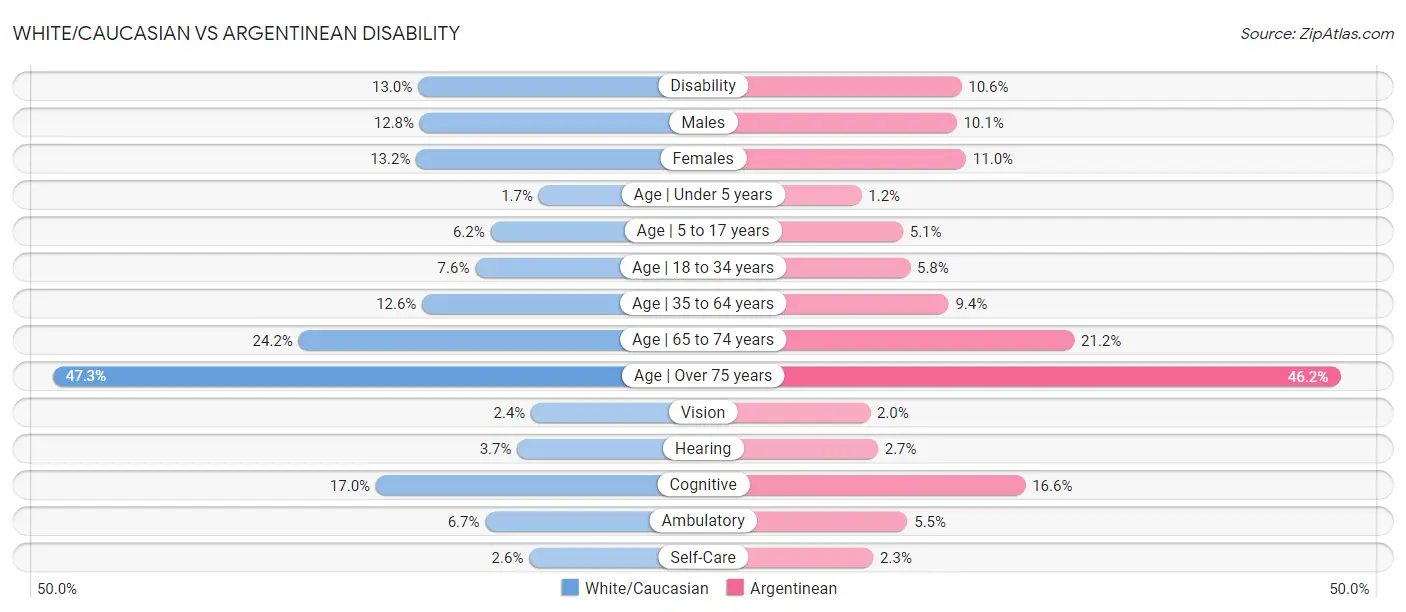
| Disability Metric | White/Caucasian | Argentinean |
| Disability | Tragic 13.0% | Exceptional 10.6% |
| Males | Tragic 12.8% | Exceptional 10.1% |
| Females | Tragic 13.2% | Exceptional 11.0% |
| Age | Under 5 years | Tragic 1.7% | Excellent 1.2% |
| Age | 5 to 17 years | Tragic 6.2% | Exceptional 5.1% |
| Age | 18 to 34 years | Tragic 7.6% | Exceptional 5.8% |
| Age | 35 to 64 years | Tragic 12.6% | Exceptional 9.4% |
| Age | 65 to 74 years | Tragic 24.2% | Exceptional 21.2% |
| Age | Over 75 years | Average 47.3% | Exceptional 46.2% |
| Vision | Tragic 2.4% | Exceptional 2.0% |
| Hearing | Tragic 3.7% | Exceptional 2.7% |
| Cognitive | Exceptional 17.0% | Exceptional 16.6% |
| Ambulatory | Tragic 6.7% | Exceptional 5.5% |
| Self-Care | Tragic 2.6% | Exceptional 2.3% |